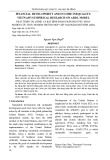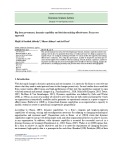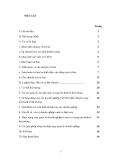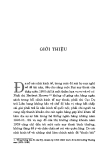
VNU Journal of Economics and Business, Vol. 4, No. 2 (2024) 1-11
1
Original Article
The impact of economic globalization on
income inequality in middle-income countries in Asia:
An empirical analysis from 2018 to 2021
Pham Thi Linh, Pham Ngoc Huong Quynh*
VNU University of Economics and Business
No. 144 Xuan Thuy Street, Cau Giay District, Hanoi, Vietnam
Received: November 13, 2023
Revised: March 28, 2024; Accepted: April 25, 2024
Abstract: This study investigates the relationship between economic globalization and income
inequality in Asia during the period from 2018 to 2021. The research aims to contribute to the
academic and policy debates on the impact of globalization on income inequality and to identify
effective policy measures that can help mitigate the negative effects of globalization on income
distribution in Asian countries. In this study, the relationship between income inequality and
economic globalization is analyzed using the Random Effects Model (REM) and Generalized Least
Squares (GLS) estimation to address the issues of auto-correlated errors and heteroscedasticity in
the selected model. The study utilizes secondary data from the World Bank about 28 middle-income
countries in Asia, spanning the period from 2018 to 2021, the International Monetary Fund, and the
United Nations Development Program. The results of the study indicate that economic globalization
is positively correlated with income inequality. The findings of this study provide insights and
recommendations that can help policymakers, academics, and other stakeholders better understand
the complex relationship between economic globalization and income inequality and identify
strategies for promoting more equitable economic growth and development in Asia.
Keywords: Economic globalization, income distribution, income inequality, middle-income
countries, policy measures.
1. Introduction *
In Asia, economic globalization has been a
significant force since the 1990s, when many
countries in the region opened their economies
to trade and investment. This has led to increased
________
* Corresponding author
E-mail address: quynhphamnh@vnu.edu.vn
https://doi.org/10.57110/vnujeb.v2i6.237
Copyright © 2024 The author(s)
Licensing: This article is published under a CC BY-NC
4.0 license.
economic growth and poverty reduction in some
countries, such as China and Vietnam, but it has
also resulted in rising income inequality in many
others, such as India, Indonesia, and the
Philippines.
VNU Journal of Economics and Business
Journal homepage: https://jeb.ueb.edu.vn

P.T. Linh, P.N.H. Quynh / VNU Journal of Economics and Business, Vol. 4, No. 2 (2024) 1-11
2
The debate on the relationship between
economic globalization and income inequality
has become increasingly relevant in recent years,
as income inequality has risen in many countries,
including in Asia. One way in which economic
globalization can exacerbate income inequality
is through trade liberalization. The removal of
trade barriers can lead to increased competition
and lower prices for consumers, which can be
beneficial for consumers and specific industries.
However, it can also lead to lower wages for
workers in specific industries, particularly those
that face competition from low-wage countries.
This can exacerbate income inequality by
widening the gap between high-skilled and low-
skilled workers (Autor, 2014). Another way in
which economic globalization can exacerbate
income inequality is through outsourcing and
offshoring. Economic globalization has made it
easier for companies to outsource or relocate
their operations to countries with lower labor
costs, which can lead to job losses and wage
stagnation in high-wage countries. This can also
exacerbate income inequality by reducing
opportunities for workers in certain industries
and widening the gap between high-skilled and
low-skilled workers (Milanovic, 2016). A third
way in which economic globalization can
exacerbate income inequality is through capital
mobility. Economic globalization has made it
easier for capital to move across borders, leading
to increased economic financializing and a
concentration of wealth among the top earners.
This can exacerbate income inequality by
widening the gap between the rich and the poor
(Stiglitz, 2016).
Overall, the relationship between economic
globalization and income inequality is complex
and multifaceted, and the impact of globalization
on income inequality may depend on a range of
factors, including the specific policies and
institutions in place in different countries. While
economic globalization has the potential to both
exacerbate and reduce income inequality, it is
important for policymakers to consider the
potential distributional impacts of globalization
policies carefully and to take steps to mitigate
negative effects on workers and vulnerable
populations. Therefore, understanding the
impact of economic globalization on income
inequality is essential for policymakers, business
leaders, and other stakeholders to develop
strategies to promote inclusive and sustainable
economic growth in middle-income countries in
Asia. What is the relationship between economic
globalization and income inequality in Asian
countries during the period of 2018 to 2021?
And how do various indicators of economic
globalization affect income inequality in these
countries?
This research analyzes the impact of
economic globalization on income inequality in
Asian countries from 2018 to 2021. The study
covers various indicators of economic
globalization. It also focuses on developing
Asian countries, to provide a comprehensive
analysis of the relationship between economic
globalization and income inequality in the
region. The research will also consider the
different factors that may influence the impact of
economic globalization on income inequality,
such as differences in economic development,
political systems, and institutional frameworks.
The study will use a range of data sources and
analytical tools to investigate the relationship
between economic globalization and income
inequality in Asia and identify policy
implications for managing the potential negative
impacts of globalization on income distribution.
The results of this paper can provide insights and
recommendations that can help policymakers,
academics, and other stakeholders better
understand the complex relationship between
economic globalization and income inequality
and identify strategies for promoting more equitable
economic growth and development in Asia.
2. Data and methodology
2.1. The model and variables
In this study, the relationship between
income inequality and economic globalization is
analyzed using a random effect panel regression
model with robust standard errors. The model is
designed to control for all variables that are fixed
over time in different countries. The robust
standard errors technique is utilized to ensure
unbiased standard errors of OLS coefficients
under heteroscedasticity, thereby avoiding
violations of the Gauss Markov assumptions.
The independent variables are economic
globalization, education, and inflation, while the

P.T. Linh, P.N.H. Quynh / VNU Journal of Economics and Business, Vol. 4, No. 2 (2024) 1-11
3
dependent variable is income inequality.
Additionally, there are other control variables
included in the model. The selection of variables
for the model is based on Jaumotte et al. (2013)
with some modifications to fit the specific
research focus. The variables used are simplified
and some require different data sources for
calculation.
Ratio = α + β1Topeni;t + β2FOpeni;t + β3FDIi;t
+ β4Ecogloi;t + β5Inflai;t + β4Lcorruptioni;t +
β5Lgdpi;t + β6Edui;t-1 + β7Edui;t
- Topen is the variable for trade openness,
measured by the sum of exports and imports of
goods and services measured as a share of gross
domestic product, provided by the World Bank
database.
- FOpen is the financial openness variable,
and the Chinn – Ito index representing this
variable (Chinn-Ito index, introduced by Chinn,
Menzie & Ito, 2006), is an index measuring a
country’s degree of capital account openness.
This index is based on the binary dummy
variables that codify the tabulation of restriction
on cross-border financial transactions reported in
the IMF’s Annual Report on Exchange
Arrangements and Exchange Restrictions).
- FDI is the variable of foreign direct
investment net inflows (% of GDP). It represents
the net inflows of investment to acquire a lasting
management interest (10 percent or more of
voting stock) in an enterprise. The data is
collected directly from the International
Monetary Fund, International Financial
Statistics and Balance of Payments databases,
World Bank, International Debt Statistics, and
World Bank and OECD GDP estimates.
- Ecoglo is the abbreviation for “The KOF
Globalisation Index”. This variable is used to
measure the rate of globalization in countries
around the world. The index is based on three
dimensions, or core sets of indicators: economic,
social, and political. Through these three
dimensions, the overall index of globalization
attempts to assess current economic flows,
economic restrictions, data information flows,
data on personal contact, and data on cultural
proximity within surveyed countries. The data
for this variable is provided by The KOF Swiss
Economic Institute.
- Infla is an inflation variable. It as measured
by the consumer price index and reflects the
annual percentage change in the cost to the
average consumer of acquiring a basket of goods
and services that may be fixed or changed at
specified intervals, such as yearly. The
Laspeyres formula is generally used. The data source
is provided by the International Monetary Fund,
International Financial Statistics, and data files.
- The corruption variable is measured by the
Corruption Perceptions Index, provided by
Transparency International. The Corruption
Perception Index (CPI) ranks countries by their
perceived levels of public sector corruption, as
determined by expert assessments and opinion
surveys. The CPI ranks 180 countries and
territories around the world, scoring on a scale of
0 (highly corrupt) to 100 (very clean).
- Edu is school enrollment, secondary
(gross), and gender parity index (GPI). The
gender parity index is the gross enrollment ratio
of girls to boys enrolled in public and private
schools. It is provided by the UNESCO Institute
for Statistics (UIS) (UNESCO, 2022).
- GDP (Gross Domestic Product) is the
variable of GDP. GDP at constant prices (real
GDP) refers to the volume level of GDP.
Constant price estimates of GDP are obtained by
expressing values in terms of a base period. Data
are in current U.S. dollars. Dollar figures for
GDP are converted from domestic currencies
using single-year official exchange rates. For a
few countries where the official exchange rate
does not reflect the rate effectively applied to
actual foreign exchange transactions, an
alternative conversion factor is used. The data is
provided by the World Bank national accounts
data and OECD National Accounts data files.
2.2. Data sources
The present study provides an analysis of 28
middle-income countries in Asia, spanning the
period from 2018 to 2021. These countries
include a diverse range of nations, such as
Armenia, Azerbaijan, Bangladesh, Bhutan,
Cambodia, China, Egypt, India, Indonesia, Iran,
Iraq, Jordan, Kazakhstan, Kyrgyz Republic,
Laos, Malaysia, Mongolia, Myanmar, Nepal,
Pakistan, Philippines, Sri Lanka, Tajikistan,
Thailand, Timor-Leste, Turkmenistan,
Uzbekistan, and Vietnam. To measure income
inequality, the study utilizes the Palma ratio,
which is a ratio of the share of all income
received by the top 10% of people with the

P.T. Linh, P.N.H. Quynh / VNU Journal of Economics and Business, Vol. 4, No. 2 (2024) 1-11
4
highest disposable income to the share of all
income received by the bottom 40% of people
with the lowest disposable income. The data for
the Palma ratio is collected from the United
Nations Development Programmer’s data
published in 2022, while the data on economic
globalization measures are sourced from the
International Monetary Fund’s (IMF) global
measurements. With this comprehensive and
diverse dataset, the study aims to provide a more
nuanced understanding of the impact of
economic globalization on income inequality in
middle-income countries in Asia.
The article uses a synthesis-analytic method;
the author has synthesized previous research
models, then performed analysis and selected a
suitable model for the data and scope of the
study. Furthermore, the author employed the
method of secondary data collection. The author
gathered and synthesized secondary data from
reputable international organizations' surveys
such as the World Bank, the International
Monetary Fund, and the United Nations
Development Program. Then, the author
aggregated and analyzed the data that were
appropriate for the research scope and
objectives. The author also used descriptive
statistical methods to get an overview of the data
provided in the article and qualitative methods to
analyze the influence of factors such as trade and
financial openness, foreign investment,
inflation, GDP, education, and corruption on
income inequality in middle-income countries in
Asia from 2018 to 2021. The authors use some
other methods to measure the variables,
specifically as follows:
2.3. The method of measuring income inequality
The use of the Palma ratio as a measure of
income inequality is widely accepted in
economic research. It provides a useful tool to
capture the level of income concentration at the
top of the distribution and the relative
deprivation of the bottom segment of the
population. The Palma ratio is preferred over
other measures, such as the Gini coefficient, as it
is less sensitive to changes in the middle of the
distribution and provides a clearer interpretation
to non-technical audiences. The Palma ratio is
particularly useful in developing countries,
where income data are often unreliable or
incomplete. Furthermore, the use of the United
Nations Development Programmer’s (UNDP)
data and the Economic Co-operation and
Development’s (OECD) data, which are both
highly regarded sources of global development
statistics, adds to the robustness and reliability of
the study's findings. The data from these sources
allowed the authors to conduct a comprehensive
analysis of income inequality in a diverse range
of countries in different regions, including both
high-income and low-income countries. The
study's use of multiple sources and a widely
accepted measure of income inequality enhances
the reliability and validity of the study’s results.
2.4. The method of measuring economic
globalization
To measure globalization, two distinct
variables are utilized, which include trade
openness and financial openness. These
variables enable researchers to separate the
impact of open trade and capital movements that
come with globalization. Trade openness is
determined by the proportion of total imports
and exports in a country’s GDP. A higher
percentage indicates a more open economy in
terms of global trade. Financial openness is
measured using the Chinn-Ito index, which
employs a set of binary dummy variables based
on the International Monetary Fund's (IMF)
limitations on cross-border financial transactions
reported in their Annual Report on Exchange
Arrangements and Exchange Restrictions. The
index was first introduced by Chinn, Menzie &
Ito (2006).
3. Results and discussion
3.1. Descriptive research results
The authors have divided 28 middle-income
countries in Asia (within the study area) into 5
regions: Southeast Asia (including Cambodia,
Indonesia, Laos, Malaysia, Myanmar,
Philippines, Thailand, Timor-Leste, Vietnam),
South Asia (including Bangladesh, Bhutan,
India, Nepal, Pakistan, Sri Lanka), East Asia
(including China, Mongolia), Central Asia
(including Kazakhstan, Kyrgyz Republic,
Tajikistan, Turkmenistan, Uzbekistan), and

P.T. Linh, P.N.H. Quynh / VNU Journal of Economics and Business, Vol. 4, No. 2 (2024) 1-11
5
West Asia (including Iran, Iraq, Jordan, Egypt,
Azerbaijan, Armenia).
Figure 1 illustrates the average growth rate
of trade (total exports and imports in total GDP)
of 28 countries within the scope of the study,
divided into 5 regions in Asia from 2018 to 2021.
There is a strong correlation between trade and
income, trade and inequality in the cross section
of countries. Countries with higher trade
openness tend to have higher living standards
and lower income inequality while the opposite
is true for countries with lower trade openness.
Overall, Southeast Asia and Central Asia are
on an upward trend, while East Asia, West Asia,
and South Asia are on a downward trend.
The Southeast Asian region had the highest
trade growth rate, consistently leading with over
90% of GDP during the study period from 2018
to 2021, reaching 97.9%, 95.33%, 90.93%, and
99.8%, respectively. Following was the East
Asian region, which only included China and
Mongolia in the study, the two largest countries
in Asia, but both were heavily impacted by the
COVID-19 pandemic.
Figure 1: The average growth rate of trade of 28 countries within the scope of the study divided into
5 Asian regions from 2018 to 2021.
Source: The authors’ compilation.
On the other hand, the West Asia and Central
Asia regions experienced significant
fluctuations. Specifically, the West Asia region
had a trade rate of 74.04% in 2018 and hit a
bottom during this period in 2020 at 56.85%.
In the Central Asia region, Kyrgyzstan is the
leading country in terms of trade ratio with
98.98%, 99.37%, 83.47%, and 108.39%,
respectively.
West Asia witnessed a decline in the trade
ratio during the period of 2018 -2021. The main
reason is explained by political instability. This
region has faced many political issues, including
the conflict between Iran and the US, and the
political crises in Lebanon, Iraq, and Syria.
Second is the decline in oil prices: West Asia
heavily relies on the oil and gas industry,
therefore, the decrease in oil prices may have
affected the economy of the region (Soliman,
2022).
The effect of foreign direct investment (FDI)
has been one of the most widely debated issues
97.90716716 95.33781789
90.92610637
99.7995635
47.70024212 46.87496849
40.71135048 44.915985
81.96082867 80.14330533
73.7964717
78.28351834
64.98709303
74.88678529
64.06444237
67.43646117
74.04109371
71.6116347
56.84505104
62.45835897
0
20
40
60
80
100
120
2018 2019 2020 2021
Percent
Year
South East Asia South Asia East Asia Central Asia West Asia










![Tài liệu về Tiền Chủ Nghĩa Tư Bản và Kinh Tế Tiền Tư Bản [Mới Nhất]](https://cdn.tailieu.vn/images/document/thumbnail/2010/20101110/hoangkha04/135x160/tien_chu_nghia_tu_ban_va_kinh_te_tien_tu_ba1_2154.jpg)















